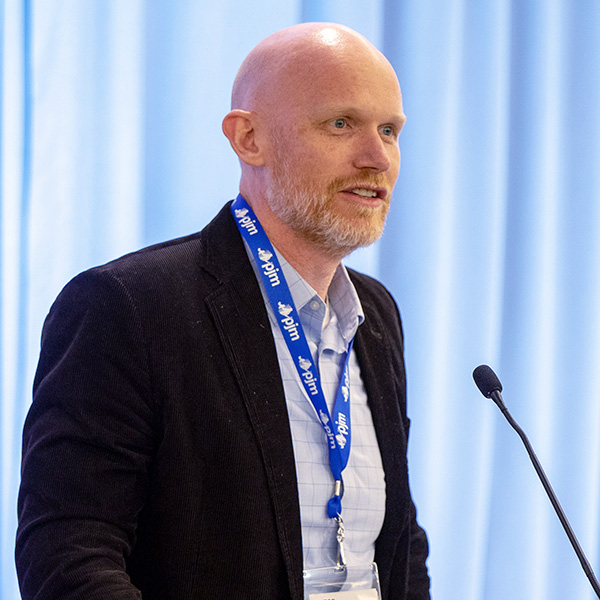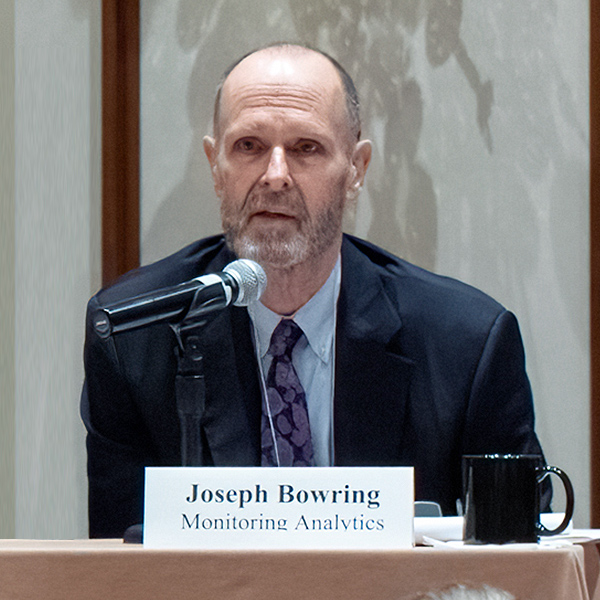VALLEY FORGE, Pa. — PJM stakeholders presented several proposals to revise how energy efficiency resources are measured and verified to the Market Implementation Committee during its July 10 meeting as the number of complaints filed at FERC against the RTO’s handling of EE market participants has grown to three.
Affirmed Energy argued that while the focus on measurement and verification (M&V) has dominated the stakeholder process on EE, it is secondary to the root issue of the addback: a process in which EE that clears in a Base Residual Auction (BRA) is removed by the supply stack and an equal amount of megawatts are added to the load forecast.
Affirmed’s Luke Fishback said the company’s proposal would aim to improve PJM’s load forecast using data from the Energy Information Administration’s National Energy Modeling System (NEMS) and only allow EE that is not captured by the forecast to participate in the capacity market. Once there is no overlap between the load forecast and market-participating EE, he said the addback could be removed and EE resources could act as reliability resources with the ability to displace other capacity offers.
The addback is the subject of a complaint that the consumer advocates for New Jersey, Maryland and Illinois filed against PJM last month, arguing that it improperly prevents EE from acting as a reliability resource and is a substantial change that should have been codified in the RTO’s governing documents and approved by the commission prior to implementation (EL24-118). (See PJM Consumer Advocates File Complaint on EE Market Design.)
Given the complaints pending over the addback, Fishback argued any changes to PJM’s M&V rules likely would be disrupted by commission orders requiring changes to the EE market design. Moving forward prior to the resolution of those complaints and a reworking of the addback would be “putting the cart before the horse,” he said.
Affirmed itself filed a complaint against PJM on July 5, arguing the RTO is improperly withholding collateral that the company posted for the 2023/24 delivery year even after approving the company’s capacity offer, approving its post-installation M&V report and the conclusion of that delivery year (ER24-124).
The complaint states PJM is withholding the collateral because of an investigation FERC’s Office of Enforcement initiated in 2021. The company wrote that it has begun laying off employees and, without the return of the funds, could be “forced out of business.”
The Independent Market Monitor also filed a complaint against Affirmed and several other EE providers in May alleging they had not met the BRA’s M&V requirements and should not be paid for the claimed EE megawatts in the 2024/25 delivery year (EL24-113). (See Monitor Alleges EE Resources Ineligible to Participate in PJM Capacity Market.)
PJM: Require Sole Causal Link Between Capacity Market and EE Installations
PJM presented to the committee its own proposal, which would tighten the participation requirements for EE resources to allow only those that can demonstrate that capacity market revenues were the only deciding factor in them materializing.
PJM’s Pete Langbein said participation should be contingent on auction revenues causing a corresponding decrease in load. “People need to do something to get paid,” he said.
Midstream and upstream programs, which work with manufacturers and retailers to stock shelves with more efficient devices, would be required to validate that participating appliances were installed and in use within the locational deliverability area in which the capacity is participating. End-use customer data would be required upon PJM request for all installations.
The period for which EE could participate in the capacity market after the installation would be shortened from four years to one, and EE no longer would be permitted to be included in fixed resource requirement (FRR) plans. FRR entities instead would be required to offer EE into the BRA.
PJM proposed a timeline of endorsement in August, a FERC filing the following month and an order in November. Langbein noted the deadline for post-installation measurement and verification (PIMV) reports is in November, but the aim is to have an order before the 2026/27 BRA scheduled to be conducted in December.
CPower’s Aaron Breidenbaugh said the 100% causation requirement is the most problematic component of PJM’s proposal and would set the bar so high that none would be able to reach it.
Fishback challenged PJM’s causation principle by noting that generators are built with the expectation of revenues beyond the capacity market. He said it effectively would eliminate EE participation in PJM’s market.
CPower Proposes Standardization of M&V, Separate Issue Charge on Addback
CPower proposed creating a process for reviewing M&V methodologies proposed by EE participants, potentially including retaining a third party evaluator. Unlike PJM’s proposal, it would not include any time limit on the validity of using state technical reference manuals (TRM) in M&V plans.
A tracking system for registering EE installations would be established to ensure that no projects are being double counted between EE providers, which Breidenbaugh said would be akin to the demand response registration process. The physical location of EE installations would be required to be identified to at least the electric distributor company.
Breidenbaugh said the proposal is designed to create a more standardized process for M&V, including by requiring nonproprietary methodologies to be made public.
The proposal also includes a problem statement and issue charge focused on revising the addback and EE forecast model, which Breidenbaugh said is meant to “divorce the issues associated with measurement and verification from some of the more contentious issues.”
Paul Sotkiewicz, president of E-cubed Policy Associates, said the M&V of EE offers stands apart from other resource classes because they are not required to be metered, potentially creating a discriminatory discrepancy compared to generating resources. He questioned whether M&V based on a TRM or external study meets PJM’s sample size requirements, and how EE providers and PJM check and verify the accuracy of those data.
Breidenbaugh said it’s difficult to compare the metering requirements of a large-scale power plant, where the cost of a meter is relatively small compared to the overall facility cost, with the nature of EE projects that could be as small as upgrading light bulbs.
Monitor Would Eliminate EE Capacity Market Participation
The Monitor presented a proposal that would remove EE from the capacity market construct outright on the basis that EE has been included in PJM’s load forecast since the 2016/17 delivery year.
“The tariff states unambiguously that EE is not a capacity resource when EE is incorporated in the load forecast used for the capacity market,” Monitor Joe Bowring told RTO Insider. “As a result, PJM recognized for the 2016/17 delivery year that EE was not a capacity resource and stopped including EE in the capacity market at that time, as they were required to do. But PJM decided to pay EE resources a side payment, or uplift, regardless. The Market Monitor’s proposal is to end that side payment, which is not provided for in the tariff.”
Bowring said consumers are overpaying for a resource that is not a capacity resource and therefore provides no reliability benefits, and there is not evidence that the uplift payments are resulting in changes in consumer behavior. Rather than being compensated through the capacity market construct, he said EE is compensated as a result of the reduced energy and capacity costs to participants. He said it is a double-counting issue that has been recognized by PJM and FERC since the introduction of EE in the RTO’s markets.
“What we’re calling EE in the PJM world should not be paid through the capacity construct. It is, as a factual and tariff matter, not a capacity resource,” he said.
Breidenbaugh said it has not been demonstrated that a majority or the entirety of EE is captured in the load forecast.
“There is a question about how much of this market energy efficiency is included in the forecast and what is not, and I would hope we would agree … that energy efficiency which is not a part of the forecast should not be subject to the addback,” he said.
Exelon Seeks Protection for State EE Programs
Exelon’s proposal merges components of the CPower and PJM proposals, including the EE registration tracker from CPower and a PJM component that would remove EE from the Capacity Performance construct, exempting EE from performance assessment interval (PAI) penalties and overperformance bonus payments.
It also would include language that state-authorized EE programs would be de facto qualified to participate in the capacity market, with the state’s legal authority held as the evidence of their validity.
Exelon’s Alex Stern said PJM approval of the original M&V plan should codify the proposed methodology that the market participant intends to use to support its capacity offer, and that approval of the PIMV report should hinge on whether that methodology was followed. Exelon also proposed to rectify a perceived flaw in PJM’s proposal that would potentially put EE providers in a penalty situation by being unable to rely on the M&V report while then also being unable to fix an after-the-fact identified problem through an Incremental Auction.
“Market participants need to be able to rely on M&V reports,” Stern said. “It is fundamental to fair EE market participation.”
Stern said all but CPower’s proposal would impinge on the ability for state-directed EE programs to participate in the capacity market. He encouraged PJM and the Monitor to engage with states to ensure they are educated on the potential impacts to those programs.
“I still strongly, strongly encourage PJM and the IMM to continue outreach to the states on this effort, but for now we wanted to try to put in a package that preserves and respects the ability for state programs to” continue participating in the market, he said. “As long as the states want the programs in the PJM capacity market, we think the rigor and regulatory scrutiny that characterizes those programs and differentiates them from other market participants should be respected in the PJM market construct.”

